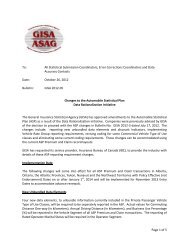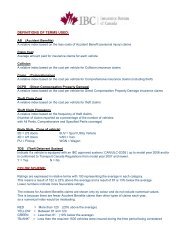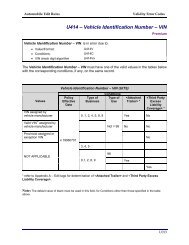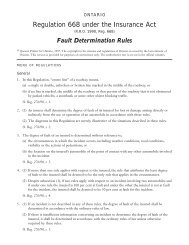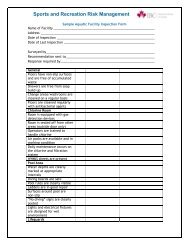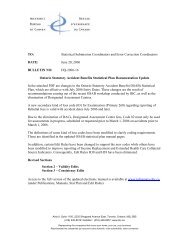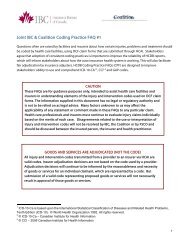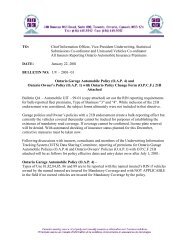Liability Loss Prevention - November 22, 2005
Liability Loss Prevention - November 22, 2005
Liability Loss Prevention - November 22, 2005
Create successful ePaper yourself
Turn your PDF publications into a flip-book with our unique Google optimized e-Paper software.
<strong>Liability</strong> <strong>Loss</strong> <strong>Prevention</strong>Definitions<strong>Liability</strong> – A legal responsibility.<strong>Loss</strong> <strong>Prevention</strong> – Actions taken in an attempt to prevent losses from occurring.Third party – A person who is not an employee, but who may be injured or haveproperty damaged.Statute of Limitations – A law that limits the amount of time within which someonemay file a lawsuit. These vary by type of legal action and by province.General liability insurance policies normally cover property damage and injury of athird party. <strong>Liability</strong> loss prevention is any measure taken to prevent or minimizethese damages and injuries.Some common liability losses include:• Damage to the property that you are being paid to work on.• Damage to property belonging to people other thanclients/customers.• Injury to clients/customers either on your premises or offpremises at a job site.• Injury to people other than clients/customers who may be inthe vicinity of your premises or job site.Key PointAn organization canbe legally liable fordamage or injuries ifall reasonableprecautions weren’ttaken to preventthem.Legal <strong>Liability</strong>All individuals and organizations have a legal obligation to conduct themselves in amanner that is reasonable and that does not willfully or negligently cause injury ordamage to others. Reasonable precautions must be taken in the conduct of youroperations to prevent such damage or injury. If you fail to take reasonable care toprevent these things from happening, you may be sued and may be responsible forcompensating people for their damages. Precautions such as regular inspections andmaintenance should be carefully documented.Risk Management1. Take the time to carefully consider the potential liabilities facedby your organization. Decide which are more likely to occur andwhich could potentially result in the greatest loss. Spend time andresources on the areas of greatest concern that could have themost significant cost or negative impact.2. Create policies and procedures on how to handle the property ofKey PointCarefully consideryour organization’spotential liabilitiesand prioritize them todetermine where tostart.
<strong>Liability</strong> <strong>Loss</strong> <strong>Prevention</strong>others.• Keep property in a secure area.• Ensure property is returned to the correct owner.3. Keep people safe.• Do not allow visitors/customers in restricted areas• Keep all premises, including parking lots and sidewalks and well lit.• Keep the premises neat and tidy. Implement a regular inspection andmaintenance schedule.I. Inspect shelves (to ensure they will not collapse and that they donot have sharp edges).II. Ensure equipment is well spaced to avoid clutter.4. Perform pre-inspections on property that belongs to a third party before he/sheleaves it in your custody. Document these inspections and make a note of anydeficiencies.• Photograph damaged areas if necessary.• Note any repairs or replacements needed.• Ensure that the owner and user sign the inspection form. This helpsdetermine that the owner and user are in agreement regarding theconditions of the property.• Ensure each party has a copy of the inspection form.5. Complete a final inspection before returning the property.• The property owner and the user should perform the inspection together.• Compare conditions with the pre-inspection.• Sign and keep a copy of the final inspection.6. Ensure enough employees/volunteers are on staff to protect visitors/customersfrom harm.• Determine the average and maximum number of clients/customers per day.• Put more employees/volunteers on duty during heavy traffic periods.• Provide training to employees/volunteers.• Ensure that employees/volunteers assist clients/customers if they are usinghazardous equipment. For example, self-dispensing machines.7. Give warning.• Place warning labels on potentially hazardous products.• Place signs to deter clients/customers from restricted areas.• Provide instructions on how to operate equipment, handlematerials/products, etc.
<strong>Liability</strong> <strong>Loss</strong> <strong>Prevention</strong>8. Implement security measures.• Install a security alarm.i. Place signs in a visible location to warn people that a securitysystem is in place.• Install electronic surveillance (security camera). Keep in mind privacyrestrictions.• Keep the premises locked after hours.• Implement a key security policy for premises.i. Ensure key-holders are known and that keys are returned afteremployment or volunteer service ends.ii. Keys should be kept in a safe place.9. Document retention• Consider storing a backup copy of records off the premises.If a fire destroys the building, backup records stored offsitewill still be available.• Consider storing data electronically. Storing dataelectronically has many advantages such as accessibilityand convenient retrieval of data. However, additionalconsiderations such as data security (hackers, crackers,etc.), personnel training and cost need to be considered.Key Point<strong>Loss</strong> of data orrecords can give riseto liabilities and canmean the loss ofrecords that could beused to defendagainst claims.Claims HandlingWhen people are injured, they should receive immediate medical attention and, ifrequired, emergency services should be contacted. In addition, the following stepsshould always be taken when an incident/accident occurs on your premises:1. Complete an incident/accident report (sample below). Documenting theincident/accident may help establish a defense against a claim presented at alater date. It may also help analyze the cause of the incident/accident andrecommend improvements to prevent similar incidents in the future.2. Contact your insurance representative to determine if the incident/accidentshould be reported to your insurer. If so, provide them with:• details of the incident/accident;• information about steps that had been taken to avoid theincident/accident.3. Take several pictures of the area where the incident/accident occurred.• Photograph any damages to the property.• Photograph the area(s) where the person was injured.
<strong>Liability</strong> <strong>Loss</strong> <strong>Prevention</strong>• Photograph the injuries that the person sustained if possible.4. Take down the names and contact information of any witnesses. Obtain and recorddetailed descriptions of the incident/accident from the victim and witnesses.5. In the event that a person is injured, instruct employees and volunteers never toadmit fault on behalf of the organization. They should say “I’m not permitted bymy employer to discuss the circumstances of the incident. I will, however, bereporting the incident immediately, and an authorized person will contact you.”Never admit liability!!6. Document all information related to incidents/accidents.7. Investigate potential causes and implement preventative measures.
<strong>Liability</strong> <strong>Loss</strong> <strong>Prevention</strong>Sample Incident ReportDate of incident: ______________ Date reported: ______________Time of incident: ______________ Time reported: ______________Location:_______________________________________________________________Reported by: Name: _____________________________________________________Position: ___________________________________________________Phone Number(s): ___________________________________________Bodily Injury:Name of injured person: __________________________________________________Phone number: _________________________________________________________Description of Injury:____________________________________________________________________________________________________________________________________________Property Damage:Description of Damage:____________________________________________________________________________________________________________________________________________Incident Description: (use reverse for more detail)________________________________________________________________________________________________________________________________________________________________________________________________________________________________________________________________________________________Witnesses:Name Address PhoneIncident <strong>Prevention</strong>:Was the Incident Preventable? Yes NoSuggested Corrective Action:____________________________________________________________________________________________________________________________________________Was the incident reported to the police? Yes NoFile Number: ____________________________________Attachments:Attach any photographs of the site where the incident occurred.Name of photographer: ___________________________________________________Date photographs taken: __________________________________________________Phone number(s): _______________________________________________________Signature: _____________________________________________________________



